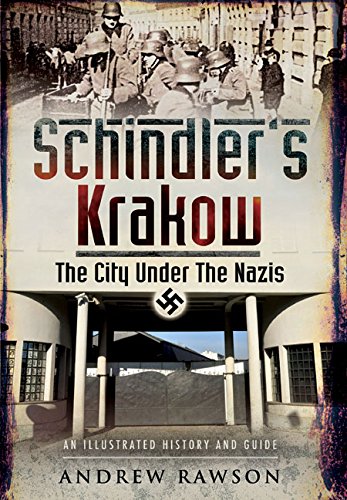Schindler's Krakow
| Title: | Schindler’s Krakow - The City Under The Nazis |
| Subtitle: | The City Under The Nazis |
| Author: | Andrew Rawson |
| Publisher: | Pen & Sword |
| Published: | 2015 |
| Pages: | 145 |
| Language: | English |
| ISBN: | 9781473827974 |
| Review: |
While the Red Army dealt with the last German resistance in the Polish city of Krakow, on January 18, 1945, the Polish national flag streamed from the tower of the Wawel castle again. The former royal residence had been the home of Nazi official Hans Frank, governor of the Generalgouvernement. Krakow was the capital city of this part of Poland that suffered severely during the German occupation in the Second World War. In "Schindler’s Krakow - The City Under The Nazis" by the British publisher Pen & Sword freelance author Andrew Rawson writes about the history of the town from the German invasion in September 1939 till the re conquest in January 1945 by the Red Army and the Polish underground resistance movement. The title of course refers to the most well-known representative of the German occupational force in Krakow, the industrial Oskar Schindler, who gained legendary fame by Steven Spielberg’s movie "Schindler’s list"(1993). In his position of factory owner he stood in the breach for his Jewish employees and saved the lives of more than 1.000 of them. The Jewish inhabitants of Krakow who could not count on his protection had little or no chance to survive. The destruction of almost the total Jewish community of Krakow plays an important role in the book. Rawson describes which steps led to the final extinction of the Jews of Krakow. Like in other cities in Poland the establishing of a ghetto played a crucial part here. The ghetto was situated in Podgórze, a district situated on the south bank of the river Vistula. On a surface of some 500 by 400 meters (approx. 550 x 440 yards) 15.000 Jews were housed in buildings where once 3.000 Poles lived. Often more than one family shared an apartment, which in many cases had no connections to the sewage system nor to the water supply. Over˗population and primitive circumstances caused deep misery. The suffering increased when the ghetto was closed down in 1942; the Jews who were not deported to the destruction camp of Belzec ended up in camp Plaszow, where the murderous camp commander Amon Göth wielded the scepter. The remains of about 10.000 murdered prisoners – both Jewish and non-Jewish – are buried still today in the neighborhood of the former camp site. Next to the Holocaust, the book also refers to the Nazi government and the Polish resistance in the town. Just like in other Polish cities under German occupation, large and small measures were issued in order to underline their inferior position vis a vis their new rulers. By removing statues of historical heroes their national past was erased. Names of squares and streets were Germanized, like the square in Krakow which was renamed from then on as Adolf Hitler Platz. The editorial offices of newspapers were shut down, members of the intelligentsia were liquidated or imprisoned in camps and access to theatres was reserved for Arians only. Next to that many Krakowians were called up for forced labor. Resistance against the occupational forces still persisted until the end of the occupation. There was even an underground police force of 2.000 strong who solved murders and robberies which could not be handled by the regular police corps by lack of capacity. The German occupation of Krakow is an example of how the Nazis subjected Polish cities to their ruthless governing. Concise and in clear language, a little bit monotonously though, Andrew Rawson describes how this process was managed. His account is complete and connects with present historical research. Unfortunately no source material is mentioned. The compact book is especially a useful guide for those parties interested in the Second World War who want to go and search for traces of the German occupation in Krakow. Especially the last chapter is of utility to them. It contains the more relevant objects of interest, like Schindler’s factory, the Gestapo museum and the Wawel castle. To those, who also want to combine a visit to Krakow with a trip to the concentration and destruction camp Auschwitz which is situated approximately 70 km (45 miles) to the west, the author recommends to also acquire "Auschwitz, the Nazi solution" by the same publisher. |
| Rating: | |
Definitielijst
- Generalgouvernement
- That part of Polish territory occupied by the Germans in 1939. It was an autonomous part of Greater Germany. In August 1941 Eastern Galicia was added to the Generalgouvernement. It was governed solely by Germans under direction of Generalgouverneur Hans Frank. It was to become a full German province inhabited only by German colonists.
- ghetto
- Part of a town separated from the outside world to segregate Jewish population. The establishment of ghettos was intended to exclude the Jews from daily life and from the rest of the people. From these ghettos it was also easier to deport the Jews to the concentration and extermination camps. Also known as “Judenviertel” or Jewish quarter.
- Holocaust
- Term for the destruction of European Jewry by the Nazis. Holokauston is the Greek term for a completely burnt sacrifice.
- invasion
- Armed incursion.
- Jews
- Middle Eastern people with own religion that lived in Palestine. They distinguished themselves by their strong monotheism and the strict observance of the Law and tradition. During World War 2 the Jewish people were ruthlessly persecuted and annihilated by the German Nazis. . An estimated 6,000,000 Jews were exterminated.
- Nazi
- Abbreviation of a national socialist.
- Red Army
- Army of the Soviet Union.
- resistance
- Resistance against the enemy. Often also with armed resources.
Images
Information
- Article by:
- Kevin Prenger
- Translated by:
- Fred Bolle
- Published on:
- 14-12-2015
- Feedback?
- Send it!




